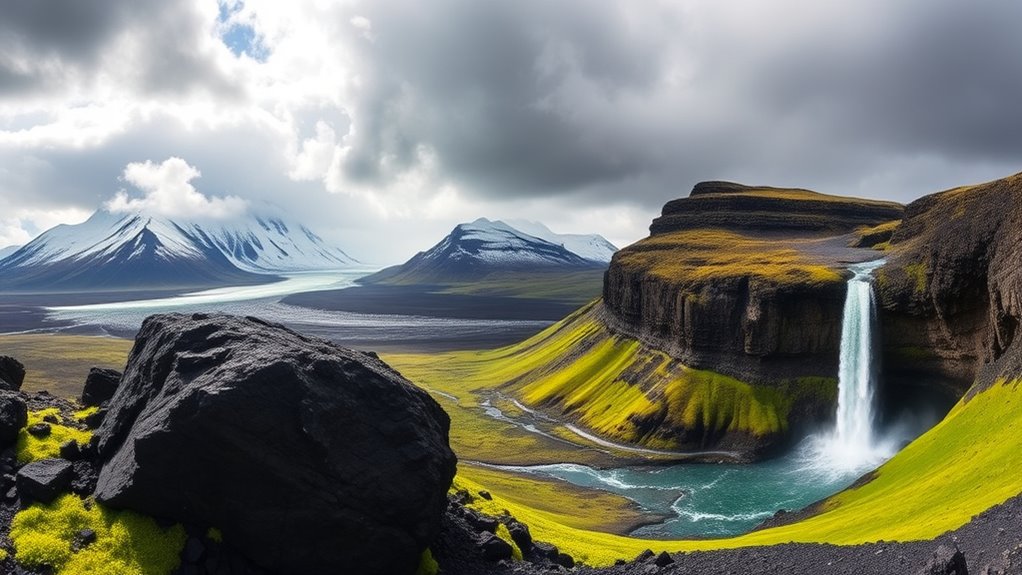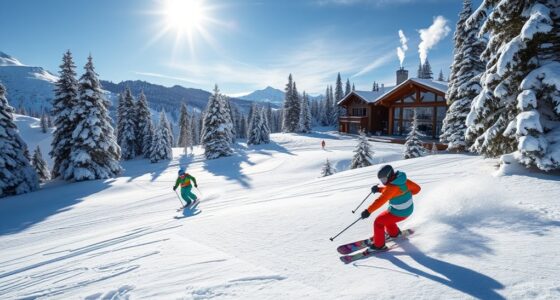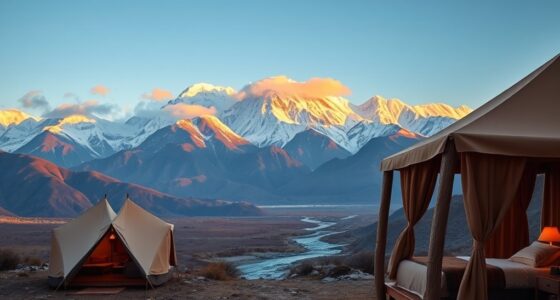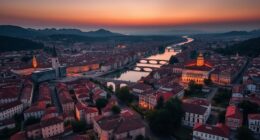In Iceland, you’re in for an adventure like no other, with stunning glaciers, roaring waterfalls, and dynamic volcanoes creating a unique landscape. Explore Vatnajökull, Europe’s largest glacier, and witness the power of nature at Dettifoss waterfall. Experience the thrill of sporty activities in Iceland’s diverse terrains, from lava fields to glacial lagoons. And don’t forget the rich cultural heritage waiting to be discovered in this extraordinary land. There’s so much more to uncover!
Key Takeaways
- Explore Vatnajökull Glacier, Europe’s largest ice cap, and witness stunning ice caves and glacial lagoons like Jökulsárlón.
- Discover Iceland’s volcanic landscape with over 200 volcanoes, including active systems that continuously reshape the terrain.
- Experience breathtaking waterfalls like Dettifoss and Gullfoss, showcasing nature’s power and beauty in dramatic settings.
- Encounter diverse climates, from subpolar oceanic conditions along the coast to tundra weather in the highlands.
- Immerse yourself in Icelandic culture through Viking heritage sites, folklore museums, and vibrant art in Reykjavik.
Geographic Wonders of Iceland
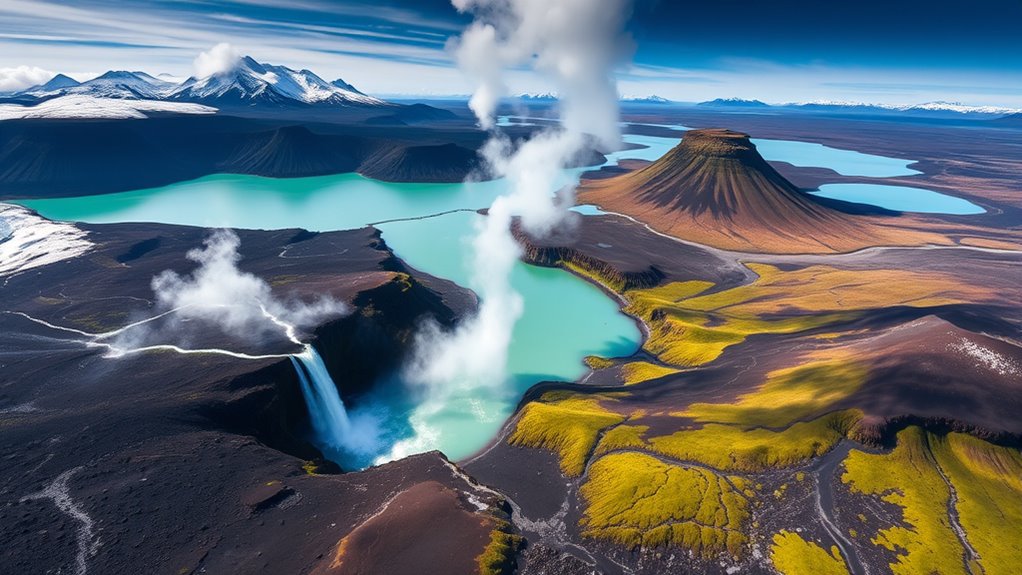
As you explore Iceland, you’ll quickly discover its stunning geographic wonders that range from majestic glaciers to unique volcanic landscapes.
You’ll be amazed by Vatnajökull Glacier, the largest in Europe, covering 13% of the country. With about 11% of Iceland’s land blanketed by glaciers, you can visit mesmerizing ice caves and glacial lagoons like Jökulsárlón, where icebergs drift serenely. Additionally, Iceland’s active volcanoes create a dynamic landscape that continuously reshapes the terrain.
Experience the awe of Vatnajökull Glacier, Europe’s largest, and explore serene glacial lagoons like Jökulsárlón.
Hiking routes around these glaciers invite adventure, leading you through breathtaking scenery. National parks like Thingvellir and Vatnajökull offer diverse landscapes and rich history, while waterfalls such as Dettifoss and Gullfoss showcase nature’s power and beauty.
Each stop reveals a new facet of Iceland’s enchanting geography, making your journey unforgettable.
The Volcanic Landscape
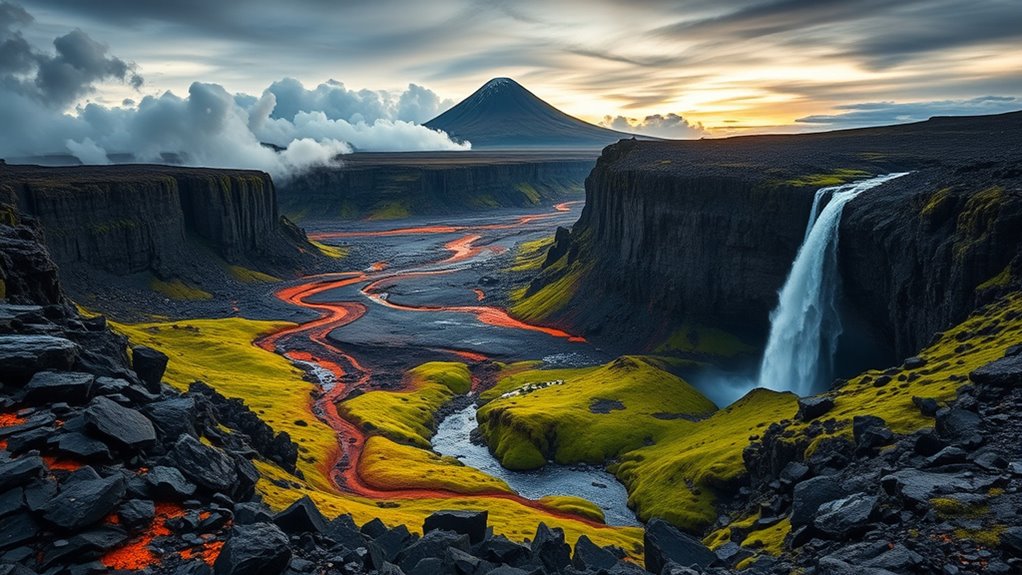
Iceland’s volcanic landscape captivates with its dramatic features, shaped by powerful eruptions and geological processes.
Sitting atop the Mid-Atlantic Ridge, you’ll discover over 200 volcanoes, with about 30 active systems. Frequent eruptions mold the terrain, forming extensive lava fields and striking volcanic craters like Víti in Krafla.
As you explore, you’ll encounter shield volcanoes and fissure vents that showcase the island’s unique geology. These volcanic zones, including the Reykjanes and West Volcanic Zones, continuously reshape the land, creating new formations.
Recent eruptions, such as those at Fagradalsfjall, remind you of the dynamic nature of this landscape. Embrace the thrill of Iceland’s volcanic activity, which plays a vital role in its beauty and complexity.
Glacial Marvels and Ice Caps
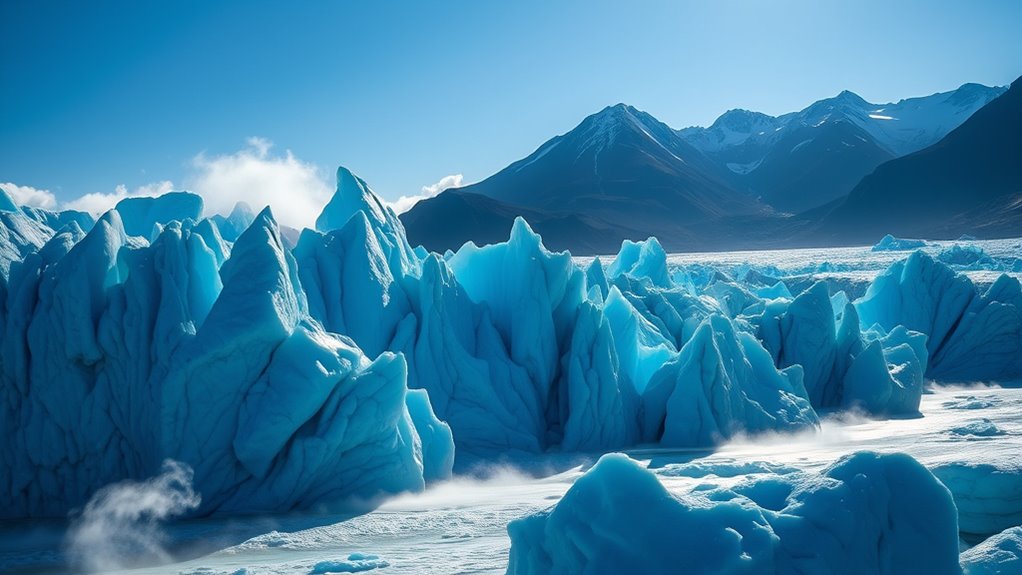
Glacial marvels dominate the Icelandic landscape, with roughly 11% of the island blanketed by stunning glaciers. The largest, Vatnajökull, covers about 7,900 km² and is Europe’s largest ice cap, influencing the local climate and creating breathtaking scenery.
You’ll encounter various types, from massive ice caps like Langjökull and Hofsjökull to smaller cirque and valley glaciers. These glaciers shape the land through erosion, forming dramatic features like Jökulsárlón lagoon, where icebergs drift.
However, you should be aware that climate change is causing these glaciers to retreat rapidly, altering the environment. Witnessing their beauty while acknowledging their fragility can deepen your appreciation for Iceland’s unique landscape and the challenges it faces.
Climate Variations and Weather Patterns

How do climate variations shape your experience in Iceland?
When you visit, you’ll notice the subpolar oceanic climate along the coast and tundra conditions in the highlands. The North Atlantic Current keeps temperatures milder than you’d expect for such a northern latitude.
Winters bring long nights and average temperatures around 0 °C (32 °F) in the south, while northern regions can drop to −10 °C (14 °F).
Winters in Iceland offer long nights with southern temperatures averaging around 0 °C, while the north can plunge to −10 °C.
Summers, with nearly 24 hours of daylight, average 10-13 °C (50-55 °F). Be prepared for rapid weather changes, especially in spring and autumn, where rain and wind can impact visibility.
With annual precipitation around 573.9 mm, expect a mix of wet and dry days, particularly in southern areas.
The Magic of the Northern Lights
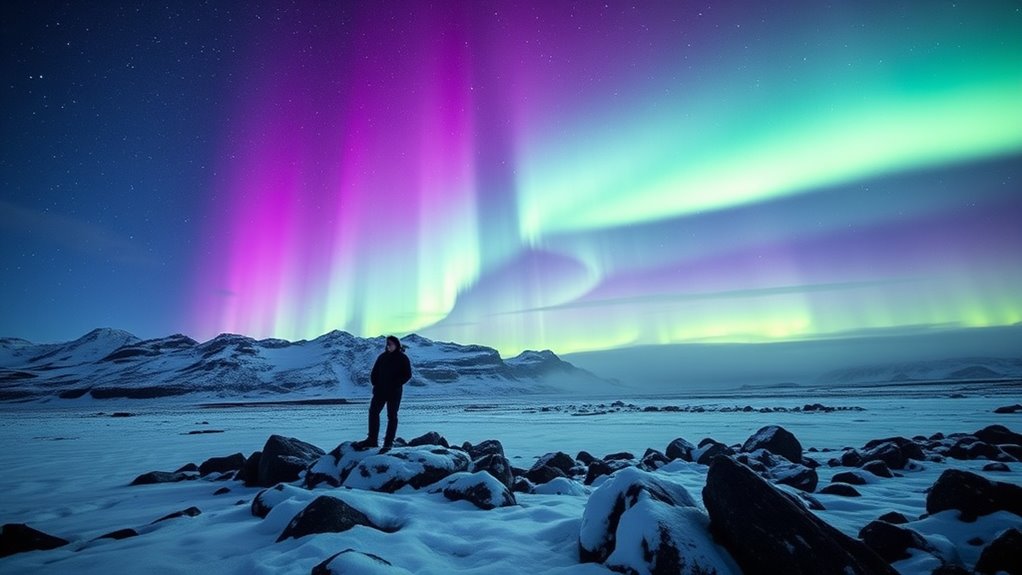
As you venture into the Icelandic wilderness, the Northern Lights can quickly transform your experience into a mesmerizing spectacle.
These breathtaking displays, created by charged particles from the solar wind, dance across the sky in vibrant colors, primarily green and red, depending on altitude.
The best time to witness this phenomenon is from late September to early April, especially around the equinoxes when solar winds are strong.
To enhance your viewing, seek out rural areas with minimal light pollution, like the Mývatn Geothermal Area or Jökulsárlón Lagoon.
With optimal conditions—dark, clear skies—your chances of seeing this magical display increase.
Exploring Unique Geological Features
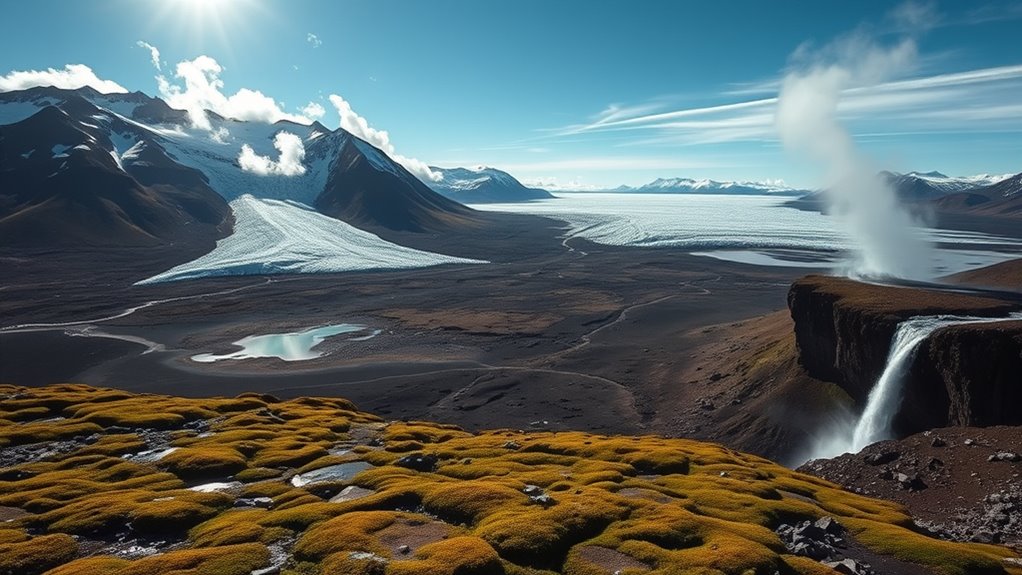
Iceland boasts a stunning array of unique geological features that showcase the dynamic forces shaping the Earth.
Iceland is a geological wonderland, showcasing breathtaking features shaped by dynamic Earth forces.
Positioned on the divergent boundary between the Eurasian and North American tectonic plates, you can witness plate rifting at an impressive rate of 1.8–1.9 cm/year. At Thingvellir, you can literally walk between these plates, feeling the power of the Mid-Atlantic Ridge.
The country’s active volcanism, illustrated by recent eruptions like Fagradalsfjall, has created vast lava fields and unique landscapes.
Explore the mesmerizing Gerðuberg basalt columns or the striking Reynisfjara black sand beach, where erosion reveals extraordinary rock formations.
Each feature tells a story of Iceland’s ever-changing terrain, making it a geological wonderland you won’t want to miss.
Thrilling Adventures in Nature
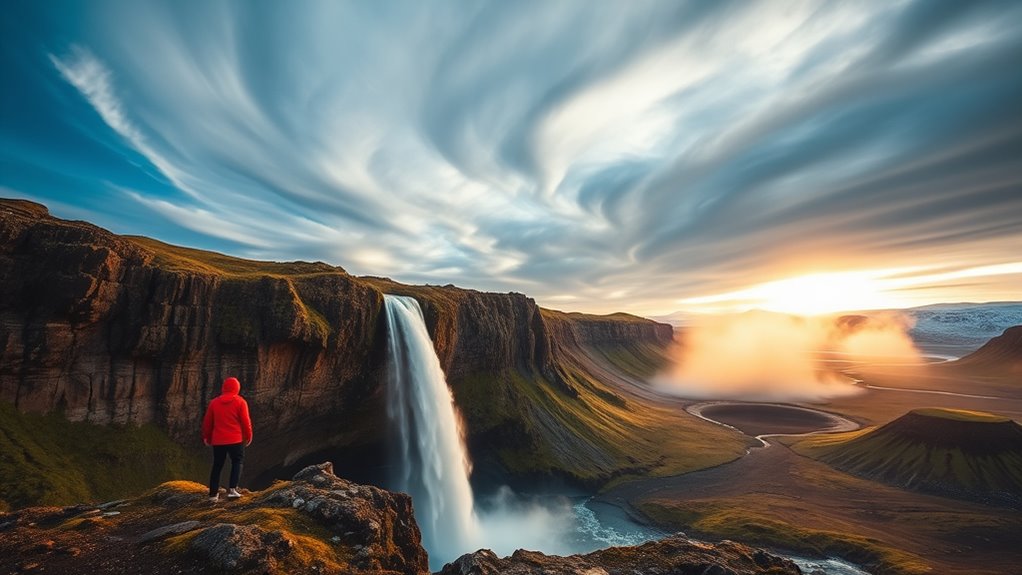
With its stunning geological features as a backdrop, Iceland offers an exhilarating playground for adventure seekers.
You can hike across expansive glaciers in Vatnajökull National Park or explore the mesmerizing ice caves of Langjökull.
Horseback riding through lava fields and along dramatic coastlines provides a unique view of this rugged terrain.
If you’re feeling adventurous, try whitewater rafting on the Hvítá River or snorkeling in the crystal-clear waters of the Silfra Fissure.
Don’t miss the breathtaking Fjaðrárgljúfur Canyon and the iconic Reynisfjara black sand beach, known for its powerful waves.
Each season unveils new adventures, whether it’s spotting puffins in spring or chasing the Northern Lights in winter.
Your Icelandic adventure awaits!
Cultural Experiences and Attractions

While exploring the breathtaking landscapes of Iceland, don’t overlook the rich tapestry of culture that awaits you.
While immersing yourself in Iceland’s stunning scenery, remember to embrace the vibrant cultural experiences that define this enchanting land.
Dive into the Viking heritage at Eiriksstadir Longhouse or the Viking World Museum, where you can marvel at ancient ships. Discover Icelandic folklore at the Sea Monster Museum and appreciate traditional turf houses at the Skogar Museum.
Reykjavik teems with vibrant art, from the National Gallery to the Einar Jonsson Museum, while the Reykjavik Arts Festival and Iceland Airwaves showcase local talent.
Don’t miss regional experiences, like the Battle of Iceland museum in North Iceland or the unique traditions in the Westfjords. Engaging in these cultural experiences will deepen your understanding of this enchanting land.
Frequently Asked Questions
What Is the Best Time to Visit Iceland for Outdoor Activities?
If you’re planning outdoor activities in Iceland, summer’s your best bet. From June to August, the trails are accessible, and you’ll enjoy long daylight hours. The weather is mild, making it perfect for hiking, whale watching, or exploring scenic routes.
However, if you’re interested in unique experiences like ice caves or the Northern Lights, consider visiting between September and March. Each season offers its own adventures, so choose what excites you most!
Are There Any Local Customs or Etiquette Tourists Should Know?
Navigating a new culture is like stepping onto a delicate dance floor; you need to move gracefully.
When visiting, remember to respect local customs. Remove your shoes in homes, greet everyone by their first names, and be open to trying unique foods.
Shower thoroughly before using pools, and understand that tipping isn’t necessary.
What Type of Clothing Is Recommended for Iceland’s Weather?
When you’re preparing for Iceland’s unpredictable weather, you’ll want to pack wisely.
Bring a waterproof and windproof outer layer to shield against rain and wind. Layer up with synthetic or wool base layers for warmth, and don’t forget a fleece sweater for extra insulation.
Sturdy, waterproof hiking boots are essential, along with warm accessories like hats and gloves.
Always be ready for sudden weather changes by including rain gear and quick-drying materials.
How Accessible Are Iceland’s Attractions for People With Disabilities?
Iceland’s attractions are increasingly accessible for people with disabilities. Many new buildings feature ramps, elevators, and accessible bathrooms.
Public transport in Reykjavík includes wheelchair-accessible buses, though you’ll need to enter and exit independently.
Natural sites like Gullfoss and Þingvellir have paved paths, while cultural venues like the Harpa Concert Hall prioritize accessibility.
Additionally, specialized tour companies and programs like “Gott aðgengi” help you find accessible services, ensuring you enjoy your visit comfortably.
What Are the Transportation Options for Getting Around Iceland?
When it comes to getting around Iceland, the saying “the journey is half the fun” rings true.
You’ve got several options at your disposal. Public buses cover major routes, especially in summer, while rental cars give you the freedom to explore at your own pace.
Domestic flights and ferries connect various towns, and for a unique experience, consider guided tours or even a campervan for the ultimate adventure.
Conclusion
As you journey through Iceland, think of it as stepping into a living canvas, where fire dances with ice, creating a masterpiece of nature. Each volcanic peak and glacial valley tells a story of resilience and beauty, inviting you to explore its wonders. Just like the Northern Lights weaving their magic across the sky, your adventure here will illuminate your spirit. So pack your curiosity and let this enchanting land reveal its secrets, one breathtaking vista at a time.
